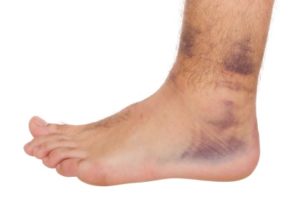Burlington Physiotherapy – Sprained Ankle
As part of our initiative to reduce the number of Burlington Soccer-related injuries this summer, this week’s post is going to teach you a little bit about ankle sprains and how we can try and prevent them. We’ll also address some of the more current methods of treatment…
Ankle Sprains in Youth Soccer
Ankle sprains account for 25-50% of all injuries in sports and 17% of soccer injuries. An inversion ankle sprain is the most common ankle sprain injury, accounting for 77%. It usually involves stepping on the lateral ridge of the foot and “going over” on the ankle, damaging the ligaments around the lateral malleolus. This is a very common injury for youth soccer players and our clinic in Burlington sees them quite regularly. There is also a lesser-known type of sprain called a high ankle sprain which can take longer to heal.
Chronic Ankle Sprains…Why?
Proprioception is a term that is commonly associated with ankle sprain. In technical terms, it is the combination of joint position sense and kinesthesia. In more simple terms, it’s the mechanism that allows us to know and feel the position of our joints without looking at them. Unfortunately, when we injure a ligament and different joint structures (as with an ankle sprain) this mechanism is disrupted and we are more susceptible to injury.
Physiotherapy for Ankle Sprains
Proprioceptive training is commonly used in sport-specific conditioning and rehabilitation in an effort to optimize our proprioception and prevent injury. In other words, we re-teach our ankle how to function properly and avoid another sprain. This is a large focus for any ankle sprain that is treated at our Burlington clinic. Unfortunately, the literature is conflicting as to the efficacy of proprioceptive and balance training for the prevention of ankle sprains. Yet, since there really doesn’t seem to be a downside to proprioceptive training, our clinic usually recommends them to our patients who may be at risk. The following is a sample of progressions for proprioceptive training…
Proprioceptive Training Progressions
1. Stand on one foot.
2. Stand on one foot and move your hanging foot in a star pattern around you.
3. Stand on one foot with your eyes closed.
4. Stand on one foot with eyes open while bouncing a ball off the wall.
5. Progress to training on unstable surfaces (like wobble boards or bosu balls).
Keep in mind that ankle instability and susceptibility to sprain is a complex issue. Things such as player position, previous injury, bracing, taping, peroneal reaction time and neuromuscular control can all be important components of prevention for some individuals.
Treatment for Ankle Sprains
If you’ve injured your ankle we hope that you call our clinic in Burlington and have it examined. Chronic, repeated ankle sprains are common with youth soccer players yet this can be prevented. The treatment for ankle sprains can vary depending on the stage of injury. In acute circumstances we usually recommend using laser therapy as a starting point. This can be performed by our Chiropractors or our Physiotherapists. Laser therapy can speed up tissue recovery and decrease swelling. The result is a faster return to play than what we would expect with traditional rehabilitative modalities like ultrasound. In more chronic cases, treatments like active release technique or graston technique can improve range of motion and tissue function. Need to get back to playing quickly? Call our Burlington Chiropractic and Physiotherapy clinic today – 905.220.7858. info@burlingtonsportstherapy.com
References
Ergen E, Ulkar B. Proprioception and ankle injuries in soccer. Clinics in Sports Medicine 2008: 27; 195-217.
Greig M, Walker-Johnson C. The influence of soccer specific fatigue on functional stability. Physical Therapy in Sport 2007: 8; 185-190.
Hughes T, Rochester P. The effects of proprioceptive exercise and taping on proprioception in subjects with functional ankle instability: a review of the literature. Physical Therapy in Sport 2008: 9; 136-147.
Kofotolis ND, Kellis E, Vlachopoulos SP. Ankle sprain injuries and risk factors in amateur soccer players during a 2-year period. The American Journal of Sports Medicine 2007: 35(3); 458-466.
McKeon PO, Hertel J. Systematic review of postural control and lateral ankle stability, part 1: can deficits be detected with instrumented testing? Journal of Athletic Training 2008: 43(3); 293-304.
Mohammadi F. Comparison of 3 preventive methods to reduce the recurrence of ankle inversion sprains in male soccer players. The American Journal of Sports Medicine 2007: 35(6); 922-926.
Ross SE, Guskiewicz KM, Gross MT, Yu B. Assessment tools for identifying functional limitations associated with functional ankle instability. Journal of Athletic Training 2008: 43(1); 44-50.
Disclaimer https://burlingtonsportstherapy.com/blog/disclaimer/









